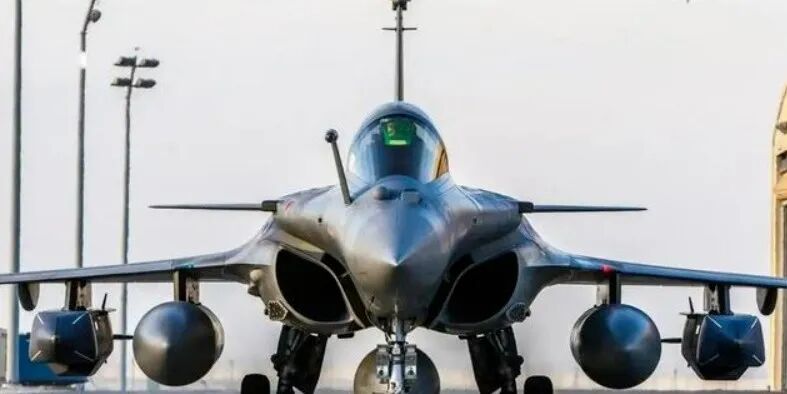
Anonymous Work
Originally published on WeChat public account “A Potential Stock”
Accompanying my country to rise
On May 7, 2025, a deafening explosion echoed over Kashmir.The Indian pride, the “Rafale” fighter jets, crashed in succession within 30 minutes. This scene left the world in shock.What made India even more embarrassed was that these $240 million “the strongest fourth and a half generation fighter in Europe” were taken down by the J-10C, which Pakistan imported from China, without even firing a missile.The Deputy Prime Minister of Pakistan excitedly announced in parliament: At that time, India deployed seventy to eighty fighter jets to attack, and we could have shot down 15 of them, but to maintain restraint, we only shot down 6.This statement left the Indian military red-faced. Just the day before, the Indian Air Force was still boasting about its “internationally sourced” equipment to the world.But who would have thought that these high-tech fighter jets, bought at a sky-high price, couldn’t even touch the shadow of their opponents in actual combat.Why did this happen?Because modern aerial combat is no longer just a simple comparison of aircraft performance. The J-10C was able to crush the Rafale due to the suppression of the entire combat system. First is the “thousand-mile eye.” The KLJ-7A radar equipped on the J-10C has a detection range of over 200 kilometers, which is a full 40 kilometers farther than the Rafale.This means that while Indian pilots were still aimlessly circling, Pakistan had already captured every move they made.Secondly, the “long arm.” The PL-15E missile equipped on the J-10C has a range of 145 kilometers, while India’s “MICA” missile has a pitiful range of only 50 kilometers.This creates a desperate reality for India: You can’t see me yet, but I can already hit you.The most critical factor is the “brain.” Behind Pakistan’s J-10C is a support system of early warning aircraft, data links, and electronic warfare systems provided by China.And what about the Indian Air Force? It is a hodgepodge of equipment from various countries, like a mixed dish, with incompatible systems and non-communicable data.
First is the “thousand-mile eye.” The KLJ-7A radar equipped on the J-10C has a detection range of over 200 kilometers, which is a full 40 kilometers farther than the Rafale.This means that while Indian pilots were still aimlessly circling, Pakistan had already captured every move they made.Secondly, the “long arm.” The PL-15E missile equipped on the J-10C has a range of 145 kilometers, while India’s “MICA” missile has a pitiful range of only 50 kilometers.This creates a desperate reality for India: You can’t see me yet, but I can already hit you.The most critical factor is the “brain.” Behind Pakistan’s J-10C is a support system of early warning aircraft, data links, and electronic warfare systems provided by China.And what about the Indian Air Force? It is a hodgepodge of equipment from various countries, like a mixed dish, with incompatible systems and non-communicable data. According to Pakistani pilots, the scene at that time was simply “the heavenly eye” against “the blind man.”As soon as the Indian fighter jets took off, they were locked onto by the early warning aircraft. By the time they were still struggling to find targets, the PL-15E missiles were already whistling towards them.This battle not only shattered India’s arrogance but also showcased the strength of Chinese military industry.From radar to missiles, from individual aircraft to systems, China has formed a complete military industrial chain, with some key technologies even leading the West.Now, the whole world understands: Spending $240 million to buy a Rafale is not as practical as buying 5 J-10Cs. Countries like Saudi Arabia have already begun to reconsider their military procurement lists.This aerial battle may reshape the global arms market landscape.However, it must be said that war is ultimately not a child’s play. While demonstrating strength, we must cherish peace even more.I hope this lesson can make India understand: True military strength has never been bought.
According to Pakistani pilots, the scene at that time was simply “the heavenly eye” against “the blind man.”As soon as the Indian fighter jets took off, they were locked onto by the early warning aircraft. By the time they were still struggling to find targets, the PL-15E missiles were already whistling towards them.This battle not only shattered India’s arrogance but also showcased the strength of Chinese military industry.From radar to missiles, from individual aircraft to systems, China has formed a complete military industrial chain, with some key technologies even leading the West.Now, the whole world understands: Spending $240 million to buy a Rafale is not as practical as buying 5 J-10Cs. Countries like Saudi Arabia have already begun to reconsider their military procurement lists.This aerial battle may reshape the global arms market landscape.However, it must be said that war is ultimately not a child’s play. While demonstrating strength, we must cherish peace even more.I hope this lesson can make India understand: True military strength has never been bought. Though humble, I never forget my country!
Though humble, I never forget my country! @Follow and retweet, that is the greatest support@
@Follow and retweet, that is the greatest support@